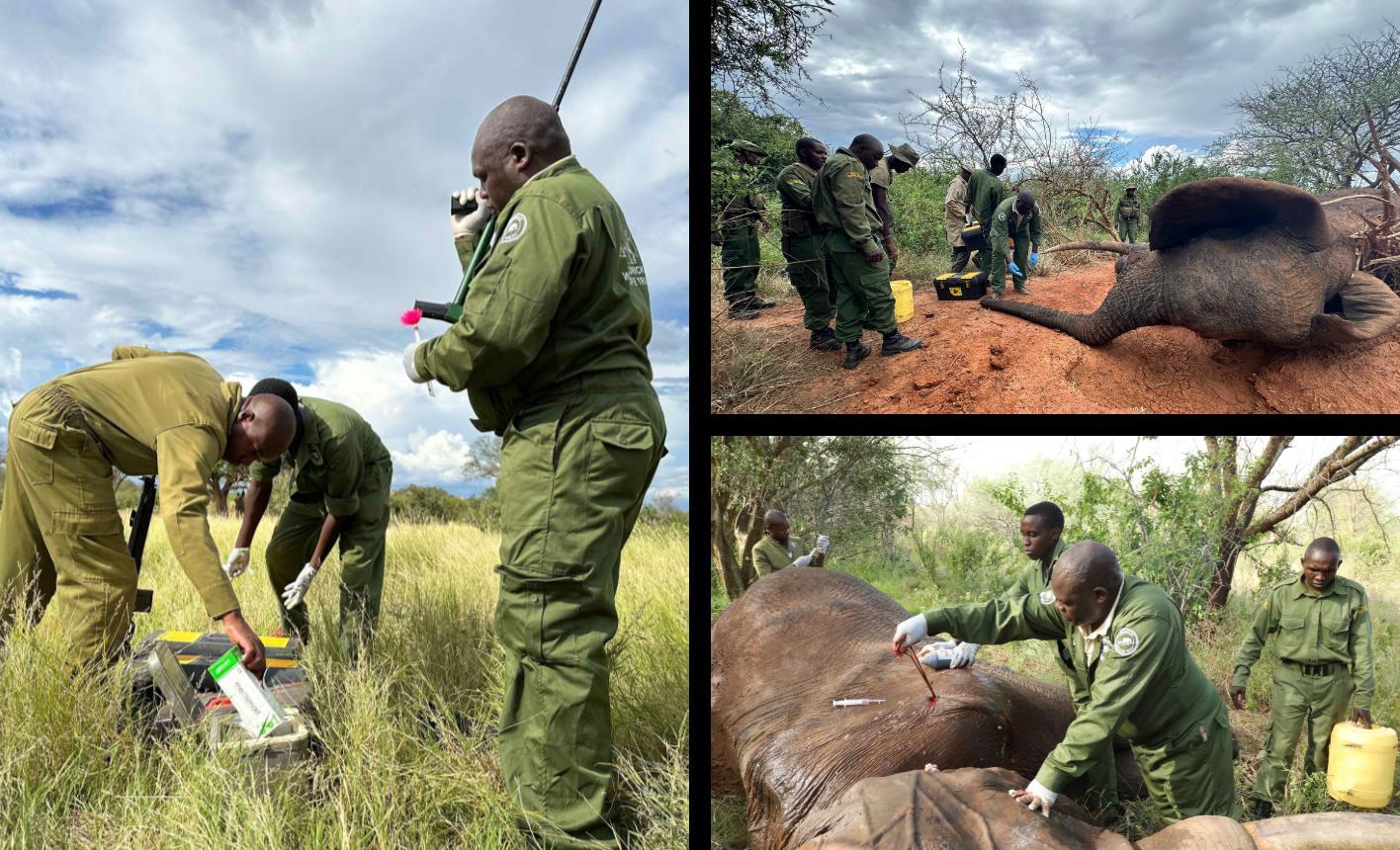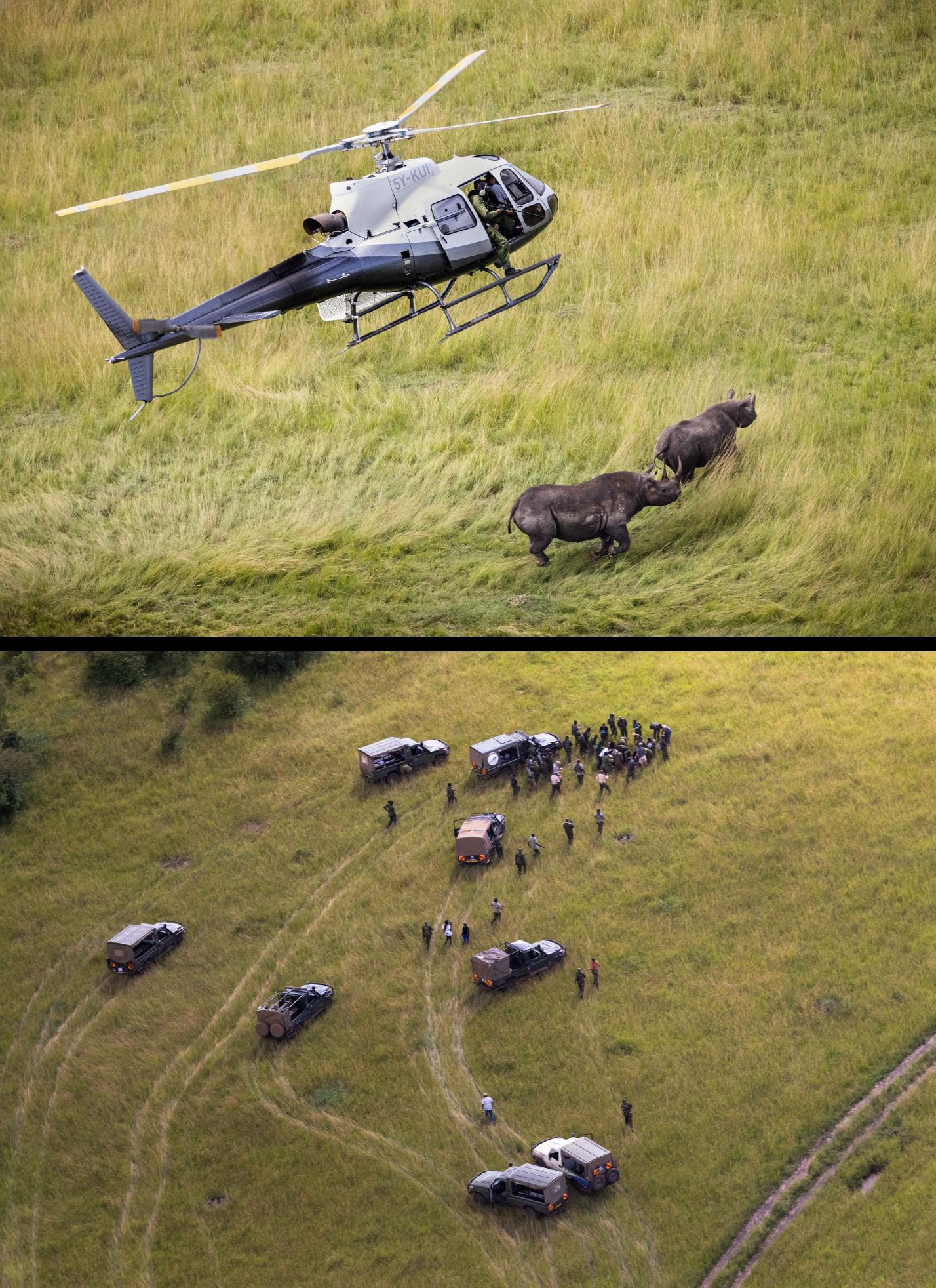

OPERATED IN PARTNERSHIP WITH THE KENYA WILDLIFE SERVICE
MARCH 2024 REPORT
S H E L D R I C K W I L D L I F E T R U S T A E
L
V E I L L A N C E
R I A
S U R

MARCH 2024
Aerial Unit Monthly Report
Operated in support of the Kenya Wildlife Service, Sheldrick Wildlife Trust's Aerial Unit monitors for illegal activity from the skies and offers rapid response assistance in anti-poaching operations, human-wildlife con�ict, veterinary treatments, orphan rescues, and all manner of �eld emergencies.
This report details Aerial Unit activities for March 2024
MONTH AT A GLANCE:
27,678
222 Hours �own:
Kilometres �own:
28,479
Tsavo East, Tsavo West, Chyulu Hills, Galana, Kulalu, Shimba Hills, Arabuko Sokoke, Tana River, Masai Mara Areas patrolled:
1
The volume of illegal activity was not remarkable during March. However, there was a marked increase in charcoal activity on Galana and Kulalu Ranches. Unfortunately, some of this is occurring in areas outside of our current in�uence New charcoal operations were started on Galana Ranch and within some areas of Kulalu, where our teams have had success in reducing or eliminating charcoal burning On one patrol over Galana Ranch, two large trucks carrying charcoal were observed in transit away from an area of extensive charcoal operations.
Illegal livestock grazing continues to be a focus for the Aerial Unit In general, the situation continues to improve and is vastly better than it was several years ago. During the month, the Aerial Unit assisted KWS and police units in Tsavo East, Tsavo West, and Galana Ranch. With cooperative magistrates, their arrests go a long way to dissuade herders from entering the parks and protected areas with their livestock
MARCH PATROL MAP:

S H E L D R I C K W I L D L I F E T R U S T A E R I A L U N I T M A RC H 2 0 2 4 R E P O RT 2
The Trust received a request to search for a young boy who had followed his mother (unbeknownst to her) into the bush to collect �rewood and got lost in Tsavo West National Park. Five days after he went missing, KWS was noti�ed and SWT was requested to aid in his search Over ten hours of �ying time were dedicated to trying to �nd the young boy Tragically, his body was later discovered by ground search parties
Later in the month, the Trust responded to a second search-and-rescue operation in Tsavo East. Tourists passed a person lying beneath a tree as they transited through the national park Initially believing it to be a herder, they offered some food and water and carried on their way. However, they later wondered if all was well with the person and made a call on their satellite phone. In partnership with KWS, we organised a search operation.
After three days of searching, both by air and on the ground, a woman was discovered by an KWS/SWT ground team, resting in the burnt shell of an abandoned vehicle not far from where she had �rst been seen. She had walked some 80 kilometres from where she came from and had spent at least four days in the Park. Miraculously, after receiving food and water, she was able to speak and relay some of her ordeal, although it should be stated that some mental impairment was suspected. She was returned to her home village by KWS.

S H E L D R I C K W I L D L I F E T R U S T A E R I A L U N I T M A RC H 2 0 2 4 R E P O RT
3

S H E L D R I C K W I L D L I F E T R U S T A E R I A L U N I T M A RC H 2 0 2 4 R E P O RT 4
Only one instance of poaching activity was observed during March's aerial patrols. This was an old shooting blind at a waterhole, which was subsequently destroyed by ground teams. Another poaching-related callout was responded to by �xed wing aircraft when one of our teams requested assistance in locating two suspects that had been spotted on a motorbike transporting bushmeat Unfortunately, they made a clean escape
In line with the lack of poaching activity observed, no poached elephants were detected in March. Only one carcass of a juvenile elephant was sighted during a helicopter patrol, which likely died of natural causes One small tusk was retrieved. Incidentally, on the same patrol, a piece of broken ivory suspected to have broken off an adult bull elephant during a �ght was also found and recovered.

S H E L D R I C K W I L D L I F E T R U S T A E R I A L U N I T M A RC H 2 0 2 4 R E P O RT
5
Five veterinary cases were assisted by the Aerial Unit in Tsavo in March. The �rst was a bull elephant sighted by Tsavo Trust personnel at Mudanda Rock in Tsavo East with a severe limp. The following day, the bull was located by our SWT/KWS Mobile Vet Unit The vet, who was in Malindi for a workshop, was collected by a SWT �xed-wing pilot and �own to Voi, where he was met by the SWT helicopter to dart and treat the bull It turns out that the bull’s injury was caused by a large stick, which had become deeply embedded in his foot pad. It took �ve men and no small effort to remove the stick. Fortunately, the bull is expected to make a full recovery.
A second bull elephant was reported by Finch Hatton Lodge in Tsavo West, also with a severe limp. The following day, the bull was located by a �xed-wing patrol before being evaluated from helicopter by the KWS/SWT Amboseli Vet Unit It appeared that the bull suffered from a broken leg With no possibility of treatment in the wild and with some con�dence that it was an old injury the elephant had learned to live with, the decision was made not to intervene
Another peculiar case presented itself near Voi, where an elephant was sighted with a heavy-duty strap wrapped tightly around its trunk and one ear As with the other two cases, the report came in late in the evening and so the elephant had to be relocated the following morning. A �xed wing set out early in the morning and upon �nding it, alerted the rest of the team. Another �xed-wing �ew to Kimana, near Amboseli, to collect the SWT/KWS Amboseli Mobile Vet Unit and bring them back to Kaluku The vet then set off in the helicopter to Voi to dart the young elephant and remove the strap While the strap’s origin remains a mystery, the elephant is undoubtedly relieved to be free of it
Two more cases were attended to in Ithumba: the �rst for a bull elephant with a severe arrow injury on his front right leg and the second a repeat treatment for a bull that previously had a poisoned arrow extracted from his shoulder The �rst bull was treated and given a guarded prognosis due to the severity and location of the injury in a joint The second bull, which had initially been given a guarded prognosis three months prior, was elevated to a good prognosis as the wound had begun to heal and his condition had improved since the last treatment.

S H E L D R I C K W I L D L I F E T R U S T A E R I A L U N I T M A RC H 2 0 2 4 R E P O RT
6

S H E L D R I C K W I L D L I F E T R U S T A E R I A L U N I T M A RC H 2 0 2 4 R E P O RT 7
Far from Tsavo, in the Maasai Mara, the Aerial Unit was involved in another veterinary exercise in support of KWS. As a part of KWS’s rhino monitoring protocol, they aim to notch the ears of 60% of any rhino population in order for them to be identi�able
In addition, a select number of rhinos were �tted with LoRa transmitters for easy tracking. Over the course of a sevenday operation, SWT contributed a �xed wing plane for searching/coordinating and a helicopter for searching/darting rhinos A combined total of 60 hours and 6,447 km were �own resulting in the successful darting and notching of 13 eastern black rhinos.

S H E L D R I C K W I L D L I F E T R U S T A E R I A L U N I T M A RC H 2 0 2 4 R E P O RT
8

S H E L D R I C K W I L D L I F E T R U S T A E R I A L U N I T M A RC H 2 0 2 4 R E P O RT 9

S H E L D R I C K W I L D L I F E T R U S T A E R I A L U N I T M A RC H 2 0 2 4 R E P O RT 10
Although not of�cially �re season, two �res were attended to by SWT. The �rst was sighted in the evening in Dida Harea, Tsavo East, and fought late into the night by KWS and SWT. The following morning the �re was surveyed by air to con�rm the previous night’s efforts had been a success Another �re was sighted during a routine �xed wing patrol on Galana Ranch, and fortunately extinguished shortly thereafter by rain showers
One routine patrol yielded unlikely passengers: While not our typical orphan rescue, a SWT pilot was called upon to collect two orphaned ostrich chicks that had been found by a herder boy near the remote town of Asa The chicks are back at Kaluku and settled into their new life, taking daily forays into the bush.
Two human-elephant con�ict cases were responded to by the Aerial Unit during the month The �rst in the area of Kanziku where, following a report from the community, a helicopter was dispatched but was unable to locate any elephants outside of the park. Upon returning a second time, 17 elephants were located, of which �ve bulls were successfully pushed back into the park. However, a family of nine, along with three young bulls, refused to cross back. In Kyusiani, three elephants which have been causing anxiety to community members for some time now, were located. Plans are being made to translocate them back into the park.

S H E L D R I C K W I L D L I F E T R U S T A E R I A L U N I T M A RC H 2 0 2 4 R E P O RT
11


The Aerial Unit, as with all Sheldrick Wildlife Trust's conservation projects, is a donorfunded initiative Thank you to our global supporters, who help us secure Kenya's habitats for the future and make an impact in the �eld, each and every day
12
© 2024 The David Sheldrick Wildlife Trust














